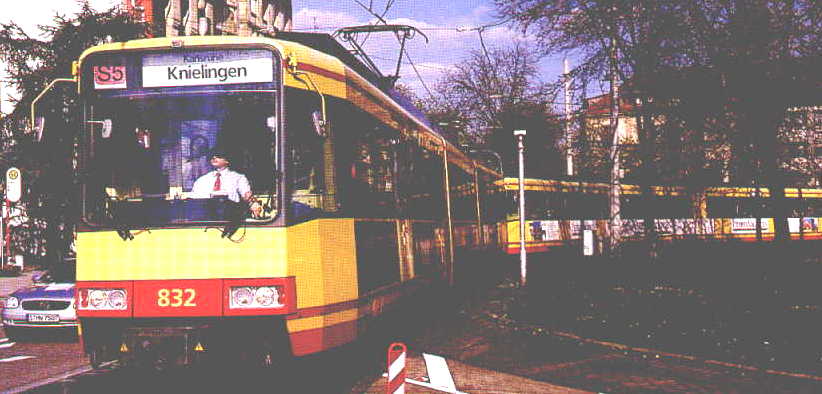
Light Rail Now and Walkable Neighborhoods (LRN) can be contacted at: Light Rail Now! |
Proponents of light rail transit (LRT) assert that operating cost savings are a major advantage for LRT and a major reason why this mode is such an attractive choice compared to various bus service alternatives. it's argued that LRT tends to be much cheaper to operate than comparable bus service, particularly for heavier passenger volumes, but even for moderate traffic as well. Moving More Riders More Efficiently Why? The short answer is: LRT attracts more passengers, for a given level of service, and then provides increased capacity more cost-effectively to transport those passengers expeditiously, safely, and comfortably.
Especially with entrained vehicles, passengers in rush hour (or other peak periods, like sports events or Christmas shopping) can be accommodated and moved much more rapidly and efficiently. Even when the trains operate on public arterials, there's significantly less conflict with other traffic than there would be if expensive fleets (or "platoons") of buses were used instead. Wishful Thinking or Reality? But are these arguments just theoretical, or is there concrete evidence to substantiate these claims for LRT? Readily available data from US operations – especially for relatively new systems – suggest that LRT does indeed tend to be much cheaper to operate than comparable bus service – most often per passenger-mile (light rail trips tend to be longer), and often per passenger as well. Comparative figures from the Federal Transit Administration's 1998 database, for the percentage cost saved by LRT (over bus service), both per boarding rider and per passenger-mile (p-m), demonstrate this. The FTA's 1998 National Transit Database (NTDB) provides data for operations and maintenance (O&M) cost, unlinked trips (boardings, or "riders", on each route link – not "linked" for a passenger's initial origin to final destination), and passenger-miles travelled (how many miles all those riders actually rode). in Table 1 below, we've selected out the statistics for all of the USA's relatively new LRT installations, using modern vehicles and engineering techniques in major corridor service. Table 1. New LRT Operating Data
Based on the data from Table 1, we've calculated the O&M (operating) cost per rider-trip (i.e., boarding rider) in Table 2, below. This table also shows the difference of LRT compared with bus – a negative value indicates that LRT cost is lower, while a positive value indicates it's higher. Table 2. Operating Cost per Rider-Trip
It can be seen that, in most cases, LRT's cost per boarding rider is significantly lower than for bus. However, the cost per rider is hardly the whole story – because LRT typically carries riders farther than buses. in other words, the average trip length tends to be longer on LRT (one reason is that it provides a more comfortable ride which attracts more travellers from cars). Why should you expect a trip of, say, 2 miles to cost the same as a trip for 20? in most cases, LRT is carrying its riders further, and so the cost per rider-trip in some cases is, indeed, higher. Therefore, a better measure of cost-effectiveness is the cost per passenger-mile. That's what we've presented in Table 3, below, also calculated from the original FTA data in Table 1. Table 3. Operating Cost per Passenger-Mile
It can be seen that, in an even greater number of cases, the cost per p-m (passenger-mile) is lower for LRT. (it should be noted that the data for Denver are for the original, very short, CBD shuttle-type service, before the first extension of the system to the suburbs to provide longer-distance, commuter-type service. Buffalo's LRT system may exhibit shorter-than-typical trip lengths since it also serves as a free shuttle and circulator system on the city's downtown Main St. Mall. As for San Jose's LRT system, while its O&M unit costs in this comparison are clearly above the norm, LRT has definitely proven its worth in providing efficient, environment-friendly passenger-carrying capability, attracting significant transit-oriented development adjacent to the line, and helping to revitalize downtown San Jose.) Curiously, LRT's lower operating cost characteristics seem to be exhibited more in real-world experience than in planning studies and alternative-analysis comparisons with theoretical bus operations. Do some planners and their consultants make erroneous assumptions in attributing greater staffing and other cost items to LRT and underestimating them for bus alternatives? in any case, the transit systems which have installed LRT, and directly experience the operational and cost benefits, know they've opted for a winner. LRT – A Money-Saver The bottom line: in almost every case, LRT demonstrates that – in the appropriate traffic corridor – it can save ongoing operating expenses compared with alternative bus operations. Rev. 2001/03/11 | |||||||||||||||||||||||||||||||||||||||||||||||||||||||||||||||||||||||||||||||||||||||||||||||||||||||||||||||||||||||||||||||||||||||||||||||||||||||||||||||||||||||||||||||||||||||||||
|
|
||||||||||||||||||||||||||||||||||||||||||||||||||||||||||||||||||||||||||||||||||||||||||||||||||||||||||||||||||||||||||||||||||||||||||||||||||||||||||||||||||||||||||||||||||||||||||||